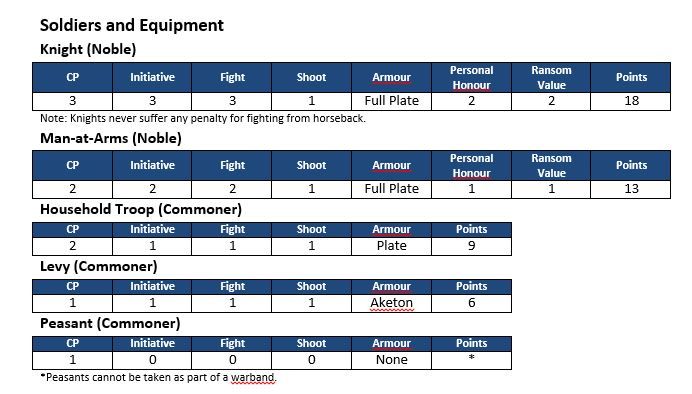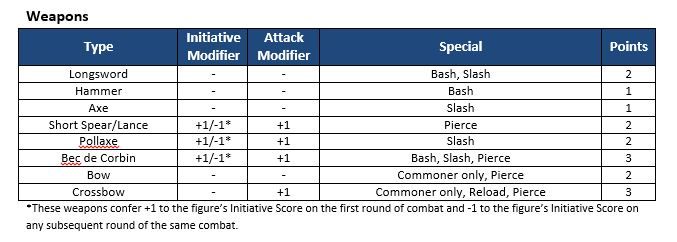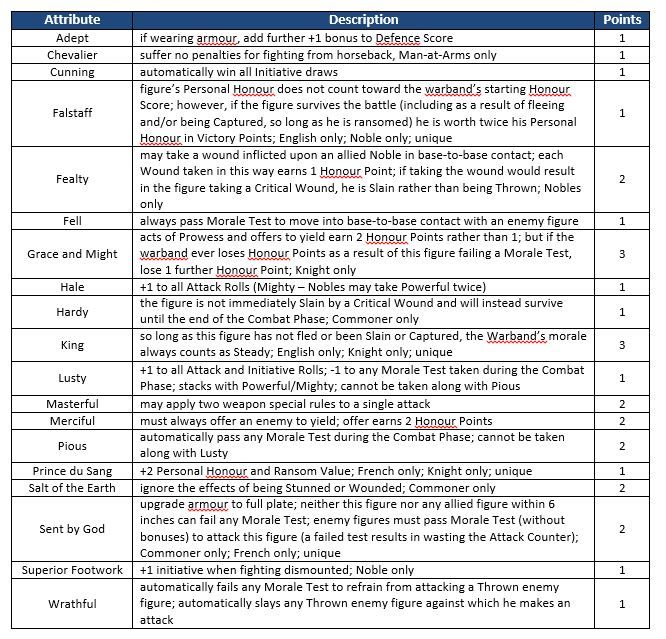Note on Conversion This conversion generally assumes that the rules of Ronin apply except where preempted (e.g., the Attributes table, army lists, weapon types, etc.) or specifically distinguished (e.g., how to count Victory Points). Where there is any question how to proceed, apply the mechanics of Ronin as amended by its published errata.
Social Rank Every figure is classified as either a Noble or Commoner. Rules pertaining to Honour generally apply only to Nobles. Nobles also have two special characteristics: Personal Honour and Ransom Value. Only Commoners may be armed with ranged weapons.
Honour Promises of glory and treasure may lure men to the battlefield but righteous feats of arms are what inspire them to stand fast in the face of danger. Conversely, craven lords lead craven men. A warband must have a starting Honour Score of no less than 6 and no more than 12 Honour Points. A warband gains Honour Points towards its starting Honour Score equal to the sum Personal Honour of its Nobles; generally 1 Honour Point per Man-at-Arms and 2 per Knight. For each figure armed with a ranged weapon in the warband, subtract 1 Honour Point from the warband’s starting Honour Score.
A warband may gain and lose Honour Points over the course of a battle but its Honour Score may never exceed 12 or be reduced below zero. The warband’s current Honour Score is used for any Morale Tests. A warband’s final Honour Score counts toward its Victory Point total at the end of a game.
Prowess Noble figures may earn Honour Points for their warband through acts of Prowess: slaying an enemy outright (inflicting a Critical Wound on a previously unwounded figure, Noble or Common); inflicting an outright Grievous Wound on an enemy Noble figure (as opposed to adding a Light Wound to an existing Light Wound); inflicting a Critical Wound (or “throwing”) an enemy Noble figure; see also Disarm and Subdue below. Acts of Prowess earn 1 Honour Point each.
Fleeing When a warband’s morale drops to Routing, each figure in that warband must make a Morale Test immediately upon activation during the Movement Phase. Nobles may add their Personal Honour as a bonus. If the figure fails, it must attempt to flee by moving as far as it can toward the nearest table edge. This is an exception to the usual prohibition against running within 1 inch of an enemy figure. The warband loses 1 Honour Point each time a Noble figure fails this Morale Test.
Even a figure that is engaged in combat must flee if he fails this Morale Test. A figure heretofore engaged in combat with a fleeing figure may forfeit moving during that Phase to make an attack against the fleeing figure. A warband will lose 1 Honour Point if a Noble figure attacks a fleeing Noble figure in this way. Noble figures generally may not voluntarily flee the table but Commoners may.
A figure that flees the table counts as a casualty for purposes of calculating Victory Points. Roll a
D6 for any Noble figure that successfully flees. On 4+ for Knights and 3+ for Men-at-Arms, that figure also counts as Captured.
Thrown Figures A figure wearing full plate does not count as Slain upon receiving a Critical Wound. Instead, the figure is considered Thrown. A Thrown figure may not spend any Attack or Defence Counters and, if attacked, has Defence Score of 2 plus his Fight Characteristic plus half of his usual Armour bonus, rounded down.
A Noble figure in base contact with a Thrown enemy figure during the Combat Phase may forgo making any attacks to request that a Thrown figure yield. This offer earns 1 Honour Point for the warband of the figure making it. Accepting the offer also earns 1 Honour Point for the warband of the yielding figure. A Thrown figure that has so yielded counts as a casualty and as Captured for calculating Victory Points.
Sometimes in the heat of battle, bloodlust overcomes chivalry. Unless the morale of the warband is Steady, a Noble figure that (a) is in base contact with a Thrown enemy figure and (b) may make an attack must make a Morale Test, adding his Personal Honour as a bonus, before offering the Thrown enemy figure to yield. If he fails, he must make at least one attack on the Thrown enemy figure. The warband of a Noble figure who makes an attack on a Thrown figure loses 2 Honour Points per attack.
The Thrown figure may refuse an offer to yield, thereby earning 1 Honour Point for his warband. He will have to survive until the next Movement Phase to get up but at that time he immediately makes a Morale Test adding his Personal Honour as a bonus. If he fails, he no longer counts as Thrown and exchanges his Critical Wound marker for a Grievous Wound marker. If he passes, he no longer counts as Thrown and exchanges his Critical Wound marker for a Light Wound marker.
Regardless of the warband’s morale, each Commoner figure in base contact with an enemy Thrown figure that has yet to yield must pass a Morale Test or make an attack on an enemy Thrown figure. If a Commoner figure is in base contact with multiple Thrown enemy figures, the controlling player may choose which Thrown figure the Commoner figure attacks. The warband loses 1 Honour Point per attack made on a thrown figure by Commoner figures.
If at least one Noble figure allied to the Commoner figures is also engaged in the combat, their controlling player may choose to have the Noble figure(s) restrain the Commoners. The Commoner figure receives a bonus to the Morale Test equal to the highest Personal Honour of any allied Noble figure engaged in the same combat.
A Noble figure in base contact with a Thrown enemy figure during the Combat Phase may spend 1 Attack Counter to demand that the Thrown enemy figure stand and fight. The warband of the Thrown figure loses 1 Honour Point if the Thrown figure refuses and gains 1 Honour Point if the Thrown figure accepts. If he accepts, the figure immediately makes a Morale Test as described above. Pass or fail, he retains his original place in combat initiative for that turn and the Combat Phase resumes. If that figure is dealt a Critical Wound or a wound resulting in a Critical Wound, he is Slain rather than Thrown.
Disarm and Subdue Disarm works as in Ronin with one exception: a Noble figure may offer an unarmed enemy Noble figure to yield, exactly as if he had been Thrown.
Subdue works as in Ronin except that a figure upon whom a successful Subdue attack has been made gains a Subdued token. A figure cannot gain a Subdued marker while it is in base to base contact with an allied figure and a figure with a Subdued marker loses that marker if an allied figure moves into base to base contact with him. If a Noble figure ends the game with a Subdued marker, he counts as Captured. Commoner figures that end the game with a Subdued marker may be released, earning 1 Honour Point for each Commoner figure so released, or Slain, earning Victory Points equal to the figure’s
CP Characteristic but losing 1 Honour Point for each Slain Commoner figure.
Successful Disarm and Subdue attempts by Noble figures count as acts of Prowess.
Capture and Ransom After the End Phase of the final turn, the Ransom Phase begins. During the Ransom Phase, the players negotiate for the release and return of Captured figures. The player seeking to free his Captured figures must have Victory Points equal to the sum Ransom Value of the Captured figures he intends to redeem from bondage. Players may also trade Captured figures of equal Personal Honour. Players can request release of any (or no) Captured figure they desire, so long as they have sufficient Victory Points or a suitable trade. For every figure “handed over” in this way, the warband which captured the figure in question earns an additional Honour Point while the receiving warband earns additional Victory Points equal to the Captured figure’s Personal Honour. The capturing warband loses 1 Honour Point for each Captured figure for whom it refuses a request to ransom.
Victory Points A warband earns Victory Points equal to the sum of the
CP Characteristic of every enemy figure Slain, Captured, or forced to flee off the table during the battle. Additionally, a warband earns 1 Victory Point every time an enemy Noble figure is Thrown. To determine which side won, compare the sum of the Victory and Honour Points attained by each warband at the end of the Ransom phase.



Aketon, plate, and full plate provide a +1, +2, and +3 bonus to the wearer’s Defence Score respectively. A shield or pavais provides a further +1 to Defence Score. A figure using a pavais may not run but, unlike a figure bearing a shield, may use a ranged weapon. Each may be equipped for 1 Point.
A Noble figure may ride into battle mounted upon a warhorse for 15 points.
Characters For every four Honour Points in a warband’s starting Honour Score, a figure may be upgraded to a Character. A Character may have a number of Attributes equal to his
CP Characteristic. Both Nobles and Commoners may be upgraded to Characters.
